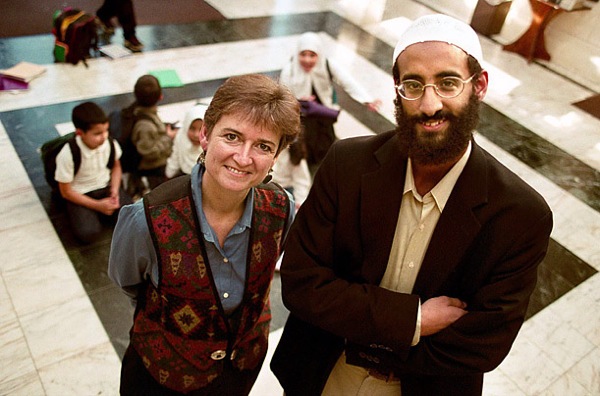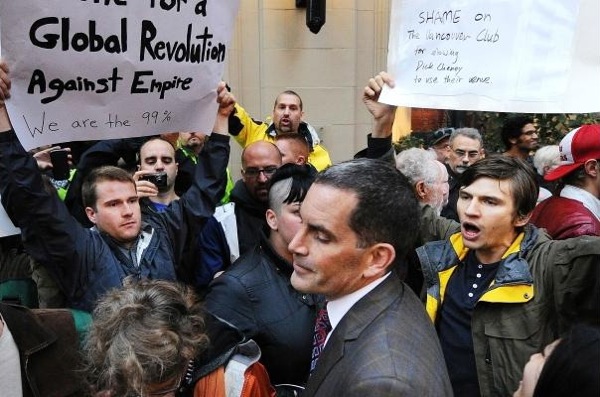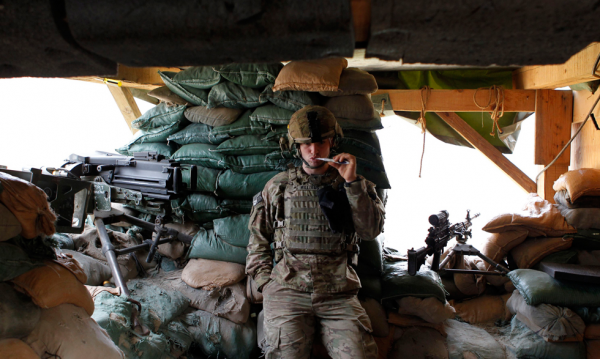Notes
al-Awlaki: What's Wrong with this Picture?

I am especially interested in this photo — and the opportunity for us to study it and think about it — since the Administration “predator-droned” Anwar al-Alwaki into the ground last Friday. (Yes, going forward, I recognize “predator drone” as a verb.)
First, let’s consider the caption from TIME’s “Anwar al-Awlaki in the United States” slideshow (keeping in mind — regardless of any ambiguity in that title — that al-Awlaki was born and raised an American). The caption reads:
Dar al Hijrah Mosque, Falls Church, Virginia
Patricia Morris, left, and Imam Anwar al-Awlaki stand inside Dar al Hijrah Mosque in Falls Church, Virginia in 2001. In Virginia, al-Awlaki served as imam of the mosque from 2001-2002, while pursuing a doctorate at George Washington University and serving as the school’s Muslim chaplain. Morris organized a vigil of solidarity at the mosque, in the weeks following the September 11 attacks.
In considering the photo, a critical thing to think about is exactly when it was taken. Unfortunately (but maybe not surprisingly, al-Awlaki now reduced to one more X-ed out evil-doer), the TIME caption leaves this ambiguous, as we have no idea if the photo was taken before or after 9/11/2001. The caption says Morris organized a vigil after the attacks, but by referring only to her (he had no involvement in it?), there is a subtle intimation that the photo was taken earlier in the year — leaving us to imagine what kind of face al-Awlaki might have presented to the WAPO photographer, Tracy. A Woodward, after the terror attack. …In point-of-fact, though, if we check GettyImages, we find out that the photograph was made on October 4th, 2001, three weeks after the attacks.
That being the case, how are we to account for the warmth and the normalcy here amidst the children, the soft and direct expression of the man in the khakis, open shirt and sports jacket, the relaxed shoulders, the only-loosely crossed arms and the sense of affinity and collegiality between the Iman and the WASP woman? Would you say that Al-Awlaki’s expression — the photo captured in that one-month period of national soul-searching prior to attacking Afghanistan, filled with compassion and gestures of goodwill and a desire for dialogue with America’s Muslim community — reflects the mood in the U.S. before America, too, became alienated by the Bush Administration’s radicalism and America experienced a progressively raw, building up of generalized hate toward the Muslim world incubating in that seventeen month stretch of time preceding the actual launch of the misguided war on Iraq?
Al-Awlaki’s story is full of contradictions. He father was a Fulbright scholar, an American academic but then, also, a member of the Yemeni government. Al-Awlaki lived in the U.S. till he was seven, returned to Yemen, then came back to the U.S. to go to college. In that stretch, he spent one summer against the Russians with the Afghan mujahideen in the pre-Taliban days.
Preaching in a mosque in San Diego after receiving an M.A. in education, it is alleged that Al-Awlaki had contact with several of the 9/11 hijackers. But then, showing no signs of radicalism, he actually moved East to make a life for himself in the DC area in January 2001, becoming the Imam at the Virginia mosque shown in the photo and also becoming the Muslim chaplain at George Washington University. After the 9/11 attacks, he even had meetings with Pentagon officials to discuss cross-cultural relations, and in 2002, he was the first imam to carry out a prayer service at the U.S. Capitol. It wasn’t till the end of 2002 that Al-Awlaki left the U.S., citing an increasing hostile climate for Muslims in the U.S. This was amidst a prosecution for passport fraud — because in 1990, he stated he was from Yemen to qualify for college scholarship money. To emphasize, much has been written about Al-Awlaki and his possible roots to terrorism, but the story is ambiguous. FBI officials claim al-Awlaki had prior knowledge of 9/11, yet it wasn’t until he arrived in Britain that his actions become demonstrably radicalized.
Which leads us back to the photo — and that ambiguity.
Now ten years beyond 9/11 and three years into Obama’s term, what does it mean, really, the idea of “looking back” and understanding? There was no inclination to look back and examine the Bush Administration’s prosecution of the so-called “terror war” and the law-breaking actions to justify the war on Iraq. At the same time, America has failed to bring the terror suspects held at Gitmo into and under the sphere of the criminal justice system. Today, the same goes for how we deal with our persistent, if aging Muslim antagonists. If anything is shocking about what happened Friday, it’s how much America’s relationship with those that hate us (against a backdrop of a Middle East, and a Muslim core, most notable now for wrestling with political freedoms) falls into the knee-jerk bucket of cowboy justice, pulverization, and targeted killings — this one, historic for the first ever of an American.
So, I’m interested in who the man is in this picture, what happened to the man in this picture, and, above all, what exactly is going on in this picture — as we all, naturally, should be. Those questions, and the ultimate answers to those questions, I would go so far as suggest, are not only vital to our American democracy but to also recovering our sense of humanity — even if this government, caught up in its warrior technology and bloodlust, could hardly give a damn.
(photo: Tracy A. Woodward/The Washington Post/Getty Images original Getty caption: Patricia Morris and Imam Anwar Al Awlaki, photographed inside Dar al Hijrah Mosque in Falls Church, VA. In background are students at the Islamic School. For a story on non-Muslims reaching out to Muslims.)


Reactions
Comments Powered by Disqus